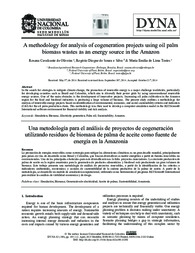A methodology for analysis of cogeneration projects using oil palm biomass wastes as an energy source in the Amazon.
A methodology for analysis of cogeneration projects using oil palm biomass wastes as an energy source in the Amazon.
Author(s): OLIVEIRA, R. C. de; SILVA, R. D. de S. e; TOSTES, M. E. de L.
Summary: In the search for strategies to mitigate climate change, the promotion of renewable energy is a major challenge worldwide, particularly for developing countries such as Brazil and Colombia, which aim to diversify their power grids by using unconventional renewable energy sources. One of the main obstacles is the development of innovative projects. Increasing oil palm cultivation in the Amazon region for the food and biodiesel industries is producing a large volume of biomass. The present study outlines a methodology for analysis of renewable energy projects based on identification of environmental, economic, and social sustainability criteria and indicators (C&I) for the oil palm production chain. This methodology was then used to develop a computer simulation model in the RETScreen® International software environment for financial viability and risk analysis.
Publication year: 2015
Types of publication: Journal article
Unit: Embrapa Eastern Amazon
Keywords: Amazonia, Biomassa, Energia, Palma de óleo, Sustentabilidade
Observation
Some of Embrapa's publications are published as ePub files. To read them, use or download one of the following free software options to your computer or mobile device. Android: Google Play Books; IOS: iBooks; Windows and Linux: Calibre.
Access other publications
Access the Agricultural Research Database (BDPA) to consult Embrapa's full library collection and records.
Visit Embrapa Bookstore to purchase books and other publications sold by Embrapa.

